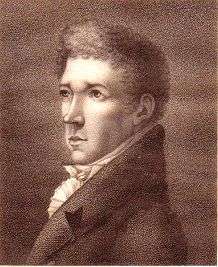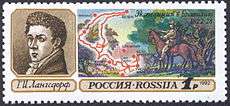Georg von Langsdorff
| Freiherr Georg Heinrich von Langsdorff | |
|---|---|
 | |
| Born |
8 April 1774 Wöllstein, Electoral Palatinate, Holy Roman Empire |
| Died |
9 June 1852 (aged 78) Freiburg im Breisgau, Grand Duchy of Baden, German Confederation |
| Nationality | German |
| Scientific career | |
| Author abbrev. (botany) | Langsd. |
Georg Heinrich Freiherr[1] von Langsdorff (8 April 1774 – 9 June 1852) was a German naturalist and explorer, as well as a Russian diplomat, better known by his Russian name, Grigori Ivanovich Langsdorf. He was a member and correspondent of the Russian Imperial Academy of Sciences and a respected physician, graduated in medicine and natural history at the University of Göttingen, Germany.
Langsdorff first participated as naturalist and physician in the great Russian scientific circumnavigation expedition commanded by Adam Johann von Krusenstern, from 1803 to 1805. He left the expedition in Kamchatka to explore the Aleutians, Kodiak and Sitka; and returned from San Francisco by ship to Siberia and thence to Saint Petersburg by land, arriving in 1808.
In 1813 Langsdorff was nominated consul general of Russia in Rio de Janeiro, Brazil. He acquired a farm (named "Mandioca," or manioc) in the north of Rio and collected plants, animals and minerals. He hosted and entertained foreign naturalists and scientists, such as Johann Baptist von Spix (1781-1826) and Carl Friedrich Philipp von Martius (1794-1868), and explored the flora, fauna and geography of the province of Minas Gerais with French naturalist Augustin Saint-Hilaire from 1813 to 1820. A recent study found that Langsdorff has 1,500 descendants in Brazil, among them the most famous is Luma de Oliveira, a Brazilian carnival queen.[2]
The Langsdorff Expedition

In 1821 he proposed to the Tsar Alexander I and to the Academy of Sciences to lead an ambitious exploratory and scientific expedition from São Paulo to Pará, in the Amazon, via a fluvial route. In March 1822, he returned to Rio in the company of scientists Édouard Ménétries (1802-1861), Ludwig Riedel (1761-1861), Christian Hasse and Nester Gaverilovitch Rubtsov (1799-1874), who would take care of zoological, botanical, astronomical and cartographical observations during the expedition. With the aim of illustrating and documenting his findings, the Baron hired painters Hércules Florence, Johann Moritz Rugendas and Adrien Taunay. The inventor of the bicycle Karl von Drais was also a participant in the expedition.

After extensive preparations, the Langsdorff Expedition departed with 40 people and 7 boats from Porto Feliz, by the Tietê river on 22 June 1826 and reached Cuiabá, in Mato Grosso on 30 January 1827. The expedition was then divided into two groups: the first one, with Langsdorff and Florence, was able to reach Santarém on the Amazon River on 1 July 1828, with enormous difficulties and suffering. Most of the members of the expedition became ill with tropical fevers (most probably yellow fever), including the Baron de Langsdorff. As a consequence of the febrile attacks, he became insane at the Juruena River in May 1828. Adrien Taunay died by drowning in the Guaporé River and Rugendas abandoned the expedition before its fluvial phase. Therefore, only Florence remained during the whole expedition. The expedition was joined again in Belém and returned by ship to Rio de Janeiro, arriving on 13 March 1829, almost three years and 6,000 km after its departure.
Huge scientific collections were deposited into Kunstkamera and later formed basis for South American collections of Russian museums. However, the rich scientific records of the expedition, comprising many descriptions and discoveries in zoology, botany, mineralogy, medicine, linguistics and ethnography, that were sent to Saint Petersburg by the expedition, were not published and were lost in the archives for a century. They were found again by Soviet researchers in funds of the USSR Academy of Sciences archive in 1930.[3] Due to the travel's hardships, Langsdorff team was unable to collect many biological specimens or study them in detail, so most of their account is geographic and ethnographic, being particularly interesting on the many indigenous people of Brazil they met, many of which became extinct. Today, a large part of the material has been recovered and is in the Ethographic Museum, the Zoological Museum and in the repositories of the Academy of Sciences of St. Petersburg.
Langsdorff returned to Europe shortly thereafter, in 1830, and died in Freiburg, Germany, of typhus, in 1852.
A species of venomous South American coral snake, Micrurus langsdorffi, is named in his honor.[4]
Media
A film documentary, featuring Adriana Florence, a grand-grand-granddaughter of Hércules Florence living in Campinas, Brazil, has been made by the Discovery Channel and retraces part of the expedition's itinerary. It also visited St. Petersburg's Langsdorff museum collections. The director was Mauricio Dias.
See also
Notes
- ↑ Regarding personal names: Freiherr is a former title (translated as Baron). In Germany since 1919, it forms part of family names. The feminine forms are Freifrau and Freiin.
- ↑ Mostra da Expedição Langsdorff no CCBB, 24 de fevereiro de 2010.
- ↑ Still Amazing Amazonia
- ↑ Beolens B, Watkins, Grayson M. 2011. The Eponym Dictionary of Reptiles. Baltimore: Johns Hopkins University Press. xiii + 296 pp. ISBN 978-1-4214-0135-5. ("Langsdorff", p. 150).
- ↑ IPNI. Langsd.
References
- Barman, Roderick J. (1971). "The Forgotten Journey: Georg Heinrich Langsdorff and the Russian Imperial Scientific Expedition to Brazil, 1821–1829". Terrae Incognitae. 3 (1): 67–96.
- Beidleman, Richard G. (2006). California's Frontier Naturalists. University of California Press. pp. 42–47.
- McKelvey, Susan Delano (1955). Botanical exploration of the trans-Mississippi West, 1790-1850. Arnold Arboretum of Harvard University. pp. 86–100.
- Langsdorff, G. H. von. Voyages and Travels in Various Parts of the World, during the Years 1803, 1804, 1805, 1806, and 1807. Illustrated by Engravings from Original Drawings. London: Printed for Henry Colburn and Sold by George Goldie, Edinburgh; and John Cumming, Dublin, 181. (hdl:2027/nyp.33433000405047) [1]
- Diaries of Russian Complex Academic Expedition into Brazil in 1824-1826 Under Leadership of Academician G. I. Langsdorff (in Russian, Russian title: Дневник русской комплексной академической экспедиции в Бразилию в 1824-1826 гг. под началом академика Г. И. Лангсдорфа). Moscow: Nauka, 1995. Available online (scroll down the page)
External links
- Indians in Brazil. In Portuguese.
- Tras las Huellas de la Expedición Langsdorff. Discovery Channel in Spanish.
- Great Russian Voyages
- ↑ "Review of Voyages and Travels in Various Parts of the World, during the Years 1803, 1804, 1805, 1806, and 1807 by G. H. Von Langsdorff". The Quarterly Review. 9: 433–443. July 1813. hdl:2027/hvd.32044092624576.